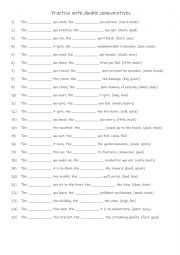
|
A2+-B1 Double comparatives
Double comparatives are a useful structure in English to express proportional relationships between two actions or situations, showing how one thing influences or depends on another. The structure typically follows the pattern: "The + comparative adjective + subject, the + comparative adjective + result." This construction helps convey cause-and-effect relationships, such as "The harder you work, the more you achieve." By using comparative forms of adjectives (e.g., "harder," "more," "better"), these sentences highlight how an increase in one factor leads to a corresponding change in another. Learning double comparatives enhances writing and speaking skills, making language more precise and descriptive, especially in contexts discussing effort, time, or improvement. Answers on page 2.
Level:elementary
Age: +9
Downloads:51 |
|
Copyright 10/11/2024 Anthoni
Publication or redistribution of any part of this
document is forbidden without authorization of the
copyright owner.
|


see more worksheets by Anthoni
|